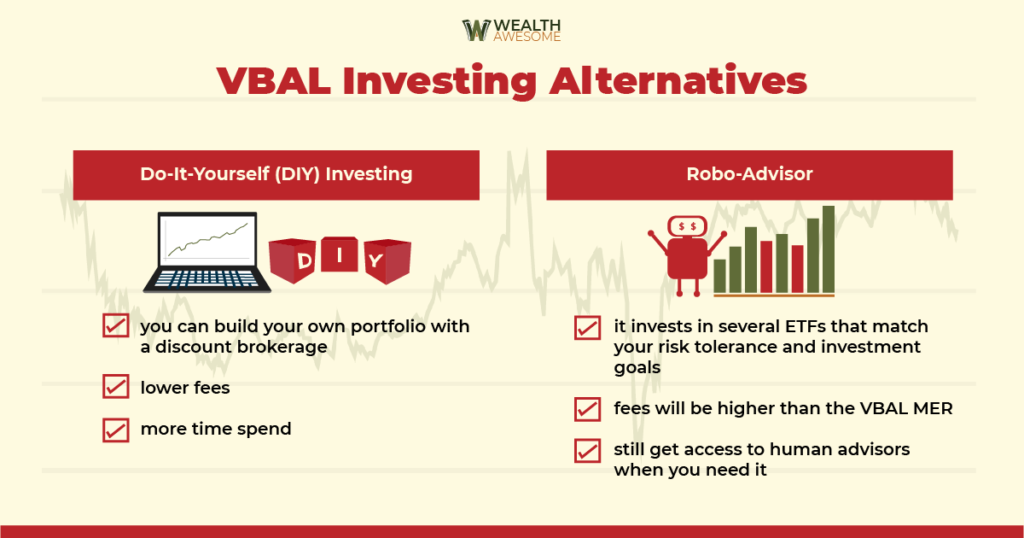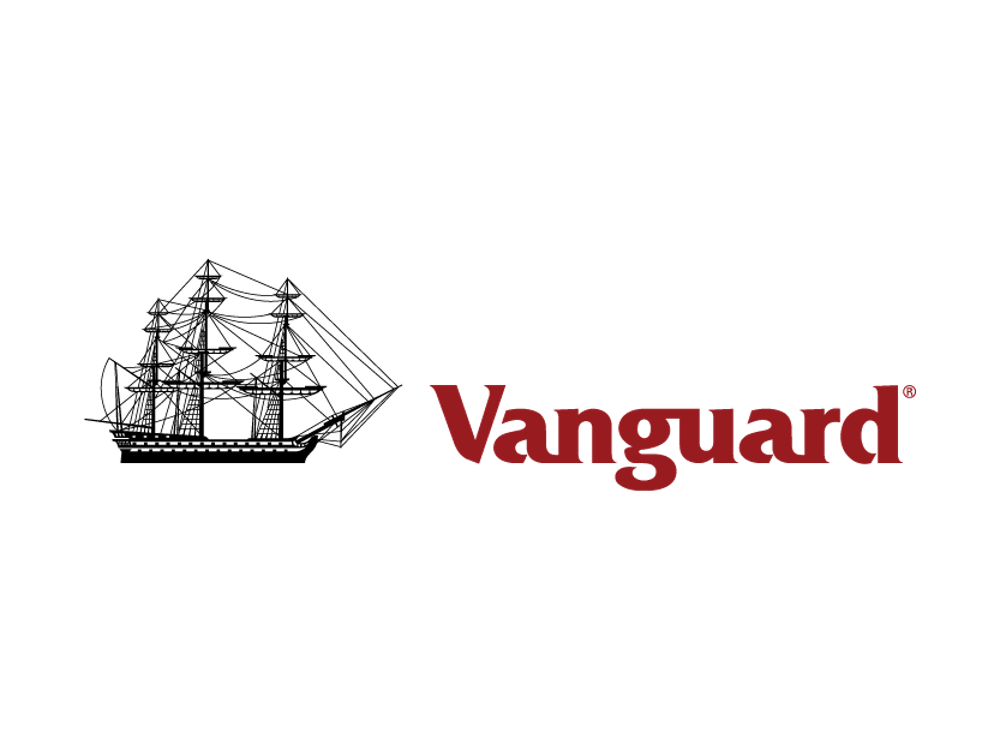If you’re looking for one of the easiest ways to invest, you must consider buying an all-in-one ETF.
Vanguard Balanced ETF Portfolio (VBAL) is one of those ETFs that you can set and forget and not have to worry about rebalancing.
VBAL is part of Vanguard Canada’s very popular asset allocation portfolio series.
Let’s take a closer look at it in this Vanguard VBAL ETF review.
Balanced ETF All-In-One Portfolio
Vanguard VBAL is an all-in-one ETF portfolio with a 60% Equity and 40% Fixed Income split that invests globally.
- Has a low MER
- No need to rebalance it
- Is simple to use
- Offers a worldwide exposure
- Is easy to buy and sell
- Home bias – heavily Canada weighted
- Has slightly higher fees than competitors
What Is Vanguard VBAL ETF?
VBAL is a balanced exchange-traded fund (ETF) portfolio that has been offered by Vanguard Canada since January 25, 2018.
The fund is part of the Vanguard portfolio series that has become popular because investors want simple and affordable access to passive investing.
Investors do not have to worry about rebalancing VBAL since the portfolios self-allocate.
VBAL is currently trading close to a price of $29.53.
VBAL Key Facts
As of Oct 11, 2023:
- Ticker Symbol: VBAL.TO
- Exchange: Toronto Stock Exchange
- Assets Under Management: $2.40 Billion
- MER: 0.24%
- 12-Month Trailing Yield: 2.32%
- Currency Traded: CAD
- Eligible Accounts: Most registered (TFSA, RRSP, etc.) and non-registered available
Vanguard VBAL MER
The VBAL Management Expense Ratio (MER) is a reasonable 0.24%.
Canadian mutual funds fees are on average about 2% per year, so VBAL is a much cheaper solution than mutual funds.
Vanguard VBAL Dividend
As of September 30, 2023:
- 12-month trailing yield: 2.32%
- Distribution yield: 2.23%
- Dividend schedule: Quarterly
VBAL Performance History
VBAL does not have much performance history since it was only introduced in 2018, but here it is:

Showing 31 Jan 2018 – 30 Sep 2023
| Fund Type | Month End | YTD | 1YR | 3YR | Since Inception |
|---|---|---|---|---|---|
| VBAL (Market Price) | −3.18% | +4.24% | +8.97% | +2.66% | +3.87% |
| VBAL (NAV) | −3.21% | +4.34% | +8.94% | +2.69% | +3.87% |
Go to the Vanguard website for real-time performance numbers of VBAL.
What Does Vanguard VBAL Invest In?
VBAL Asset Allocation
VBAL aims to invest about 60% in equity and 40% in fixed income.
As of October 12, 2023:
| Stocks | Bonds | Short-term Reserves |
| 60.52% | 39.39% | 0.09% |
VBAL Vanguard ETF Allocation
It is made up of several different Vanguard ETFs and is designed to give worldwide market exposure to its investors.
The fund includes Canada, the U.S., global, all-cap indexes equities, and even a small portion of emerging markets.
It also includes fixed income from Canada, the U.S., and global countries.
As of Aug 31, 2023:
| Fund | |
|---|---|
| U.S. Total Market Index ETF | 26.76% |
| Canadian Aggregate Bond Index ETF | 23.32% |
| FTSE Canada All Cap Index ETF | 18.05% |
| FTSE Developed All Cap ex North America Index ETF | 11.46% |
| Global ex-U.S. Aggregate Bond Index ETF (CAD-hedged) | 8.37% |
| U.S. Aggregate Bond Index ETF (CAD-hedged) | 7.73% |
| FTSE Emerging Markets All Cap Index ETF | 4.31% |
Vanguard VBAL Holdings – Top Stocks
VBAL top holdings are some of the biggest stock names in Canada and the U.S.
As of Aug 31, 2023:
| Holding Name | % of Market Value | Sector |
|---|---|---|
| Apple Inc. | 1.65% | Computer Hardware |
| Microsoft Corp. | 1.43% | Software |
| Royal Bank of Canada | 1.06% | Banks |
| Toronto-Dominion Bank | 0.94% | Banks |
| Amazon.com Inc. | 0.71% | Diversified Retailers |
| NVIDIA Corp. | 0.68% | Semiconductors |
| EUR/USD FWD 20230905 | 0.66% | — |
| EUR/USD FWD 20230905 | 0.66% | — |
| Shopify Inc. | 0.65% | Consumer Digital Services |
| Canadian Pacific Kansas City Ltd. | 0.63% | Railroads |
VBAL Market Allocation
Here is the country and region that VBAL invests in; it is quite comprehensive:
As of Aug 31, 2023:
| Country | Region | Fund |
|---|---|---|
| United States of America | North America | 44.3% |
| Canada | North America | 29.9% |
| Japan | Pacific | 4.5% |
| United Kingdom | Europe | 2.8% |
| China | Emerging Markets | 2.2% |
| France | Europe | 1.9% |
| Switzerland | Europe | 1.6% |
| Germany | Europe | 1.4% |
| Australia | Pacific | 1.4% |
| India | Emerging Markets | 1.3% |
| Total | 91.3% |
VBAL Portfolio Characteristics
Here are some key ratios and statistics for VBAL’s stocks and bonds. With over 13,000 stocks, you are extremely well-diversified
As of Aug 31, 2023:
Stocks
| Fundamentals | Fund |
|---|---|
| Number of Stocks | 13,626 |
| Median Market Cap | $74.4 B |
| Price / Earnings Ratio | 16.5 x |
| Price / Book Ratio | 2.2 x |
| Return on Equity | 14.2% |
| Earnings Growth Rate | 13.9% |
Bonds
| Fundamentals | Fund |
|---|---|
| Number of Bonds | 18,860 |
| Average Duration | 7.0 years |
| Average Maturity | 10.2 years |
| Average Coupon | 2.7% |
| Short-term Reserves | 0.1% |
VBAL Market Capitalization
VBAL invests mainly in large-cap companies but has exposure to several other asset size categories as well.
As of Aug 31, 2023:
| Capitalization | Fund |
|---|---|
| Large | 78.14% |
| Medium/Large | 3.50% |
| Medium | 9.58% |
| Medium/Small | 4.00% |
| Small | 4.76% |
| Total | 99.98% |
VBAL Vanguard Sector Weighting
The top four sectors of VBAL ETF stocks are financials, technology, industrials, and consumer discretionary.
As of Aug 31, 2023:
| Sector | Fund |
|---|---|
| Technology | 18.95% |
| Financials | 18.72% |
| Industrials | 13.0% |
| Consumer Discretionary | 12.03% |
| Energy | 8.57% |
| Health Care | 8.22% |
| Basic Materials | 6.2% |
| Consumer Staples | 4.91% |
| Utilities | 3.58% |
| Telecommunications | 3.03% |
| Real Estate | 2.77% |
| Other | 0.00% |
| Total | 100.00% |
VBAL Distribution by credit quality
As of Aug 31, 2023:
| Credit Rating | Fund |
|---|---|
| AAA | 32.8% |
| AA | 36.1% |
| A | 18.2% |
| BBB | 12.6% |
| Less than BBB | 0.0% |
| NR | 0.4% |
| Total | 100.0% |
VBAL Distribution by credit issuer
As of Aug 31, 2022:
| Issuer | Fund |
|---|---|
| Treasury | 39.5% |
| Local Authority | 23.7% |
| Industrial | 10.2% |
| Financial Institutions | 9.5% |
| Agency | 8.2% |
| Mortgage Backed Security Pass-through | 3.4% |
| Utility | 1.9% |
| Covered | 1.5% |
| Supranational | 1.3% |
| Sovereign | 0.3% |
| Commercial Mortgage Backed Security | 0.3% |
| Other | 0.2% |
| Asset Backed Security | 0.1% |
| Total | 100.00% |
VBAL Distribution by credit maturity
As of Aug 31, 2023:
| Maturity | Fund |
|---|---|
| Other | 0.2% |
| Over 25 Years | 10.7% |
| 20 – 25 Years | 5.4% |
| 15 – 20 Years | 5.8% |
| 10 – 15 Years | 5.0% |
| 5 – 10 Years | 30.1% |
| 1 – 5 Years | 42.2% |
| Under 1 Year | 0.5% |
| Total | 100.0% |
VBAL Risk And Volatility
As of Aug 31, 2023:
| Fund Type | R-Squared | BETA | ALPHA | Standard Deviation | Sharpe Ratio |
|---|---|---|---|---|---|
| Fund | — | — | — | 9.35% | 0.21 |
| Benchmark | — | — | — | — | — |
Vanguard VBAL ETF vs Other ETFs
VBAL vs VGRO
VGRO is Vanguard’s Growth Portfolio ETF. Similar to VBAL, VGRO also consists of many other Vanguard ETFs and is self-allocating.
However, their main difference is that VGRO is less conservative. It aims for around 80% equity and 20% fixed income, whereas VBAL aims for around 60% equity and 40% fixed income.
Read a full VGRO review here.
VBAL vs XBAL
XBAL stands for iShares Core Balanced ETF Portfolio. With XBAL, you’ll get a slightly lower MER of 0.2%. You’ll also get more exposure to the U.S. market and less exposure to the Canadian equity market. So, XBAL is a good alternative to VBAL.
Read a full XBAL review here.
VBAL Investing Alternatives

Despite the advantages of all-in-one portfolios, they might not be for everyone. However, there are a couple of good alternatives, like DIY investing and robo-advisors.
Do-It-Yourself (DIY) Investing
With DIY investing, you can build your own portfolio with a discount brokerage. Although you’ll be spending more time rebalancing your investments and researching what to purchase, the fees will be lower.
An online brokerage like Questrade or Wealthsimple Trade can help you make commission-free trades.
Read a full review of Wealthsimple Trade here.
Robo-Advisor
A robo-advisor, on the other hand, has a similar investment philosophy as the VBAL portfolio. It also invests in several ETFs that match your risk tolerance and investment goals.
Robo advisor fees will be higher than the VBAL MER, but you can also get access to human advisors when you need them.
Read a full review on Wealthsimple, the leading robo-advisor in Canada here.
You can also read a list of what I think are the top investment options in Canada here.
VBAL Tax Considerations
VBAL, being domiciled in Canada, offers certain tax efficiencies for its holders. Since it primarily holds Canadian securities, there is no withholding tax on dividends within registered accounts such as TFSAs and RRSPs.
However, for the international portion of its holdings, VBAL indirectly holds U.S. and international equities and bonds through other Vanguard ETFs. This structure may result in some level of foreign withholding tax leakage, especially in non-registered accounts. Investors should be aware that the tax implications can vary based on the type of account they hold VBAL in.
Who Should Buy Vanguard VBAL?
VBAL is highly recommended for you if:
- You want an all-in-one balanced investment portfolio that gives you exposure to stocks and bonds.
- The asset allocation of about 60% equity and 40% fixed income suits your risk tolerance level and investment goals. There’s this Vanguard investor questionnaire that you can take if you’re uncertain.
- You don’t want to spend time rebalancing your investments.
How to Buy Vanguard VBAL ETF
You can purchase ETFs in Canada through most Canadian brokerage platforms that offer stock and ETF trading. My top choices are Wealthsimple Trade and Questrade.
| Image | Product Title | Features | Price |
|---|---|---|---|
Editor's Choice  |
| Get $25 Signup Bonus | |
Reliable Pick  |
| Get $50 Free Stock Trades |
To learn more, check out my full breakdown of the best trading platforms in Canada here.
Conclusion
VBAL is an excellent choice for Canadian investors who don’t want to construct their own balanced portfolios.
Vanguard is one of the top ETF providers that is changing the way that many Canadians are investing.
Here’s a full overview of Vanguard’s funds for you to learn more.






Hi,
I am looking to find a Vanguard US equivalent ETF to VBAL. Can you help me please?
Hey Pat, I don’t think they have an equivalent for the U.S, you can construct your own though pretty easily, see this for more details: https://investor.vanguard.com/etf/investment-options
Hi Chris,as a senior aged investor I am going to switch from mutual s to etf,s.In your opinion is this a good idea and is veal a good choice
Thanks Tom
Hey Tom, many investors are switching from mutual funds to ETFs due to the lower fees. It depends on your unique circumstances though and it’s hard to say without knowing more information. I will be making a course about how to invest in ETFs soon, maybe you will be interested in that? I can add you to the list if you are interested.
If I am heavily invested in VBAL and then later decide I want to be more aggressive with my investments. Should I sell my VBAL and buy VGRO ?
OR
Should I buy a Vanguard Total Index ?
OR
is it better to start a new portfolio where I manually adjust stocks to bond ratio ?
Hey Dan, yes that would be a good strategy, to switch to VGRO if you want to be more aggressive. That would be the easiest transition. If you buy just vanguard total index, you would be 100% equities which I don’t recommend for most people. The third option is the cheapest, but also will take you the most time because you will have to rebalance it from time to time.
Hi Chris, Thanks for the quick reply.
I am leaning more towards VGRO since like you said its the easiest.
I was also thinking what if I mix 100% equities like Vanguard total index to my VBAL ?
Is mixing equities with a already all in one solution like VBAL ( VBAL + 100% equities ) a good idea ?
Do you still recommend I go with VGRO instead of mixing ?
Ah I understand your question now. I would recommend going all VGRO instead of mixing. If you mix, it kind of defeats the purpose of the portfolio. You’ll be getting a lot of overlapping and duplicate purchases of stocks. Either go full portfolio, or full mixing (example is an equity ETF combined with a fixed income ETF)
Hi Chris! I have a question about fees for asset allocation funds that have underlying ETFs. Say for VBAL the MER is 0.25%. It’s made up of a bunch of ETFs which all have their own MERs. Are there any invisible fees that get included from the underlying funds in addition to the overall VBAL fee? or is 0.25% what you pay.
Thanks!
Hi Catherine, no there are no additional MER fees. The 0.25% is the total MER for VBAl, even though it consists of other ETFs.